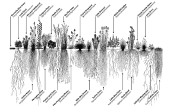









 4
4




Tom Connolly wrote:I will very likely be buying land in high plains desert that gets about 10" of rain per year. I have just started to read about greening the desert and discovered that there is way more info out there than I thought. The purpose of this post is to gather information to help me do research on a specific topic. The topic: is it an effective strategy to dig a deep hole - deep being 20 to 40 feet - that a tree will be planted in and stuff the hole with a variety of nutrients, organic matter, worms, etc to help train tree roots to grow deep and fast, develop stability and more quickly become water self sufficient?
 Two, I think you are in pretty great danger of creating an area that will cause the roots to grow outward, hit the edges of your hole, and start going around in circles. This may or may not kill the tree, but will certainly stunt it if it happens.
Two, I think you are in pretty great danger of creating an area that will cause the roots to grow outward, hit the edges of your hole, and start going around in circles. This may or may not kill the tree, but will certainly stunt it if it happens.

"People may doubt what you say, but they will believe what you do."




 2
2




"The rule of no realm is mine. But all worthy things that are in peril as the world now stands, these are my care. And for my part, I shall not wholly fail in my task if anything that passes through this night can still grow fairer or bear fruit and flower again in days to come. For I too am a steward. Did you not know?" Gandolf
 5
5





 2
2




List of Bryant RedHawk's Epic Soil Series Threads We love visitors, that's why we live in a secluded cabin deep in the woods. "Buzzard's Roost (Asnikiye Heca) Farm." Promoting permaculture to save our planet.
 5
5




 1
1




 1
1








Come join me at www.peacockorchard.com
 2
2




Check out Redhawk's soil series: https://permies.com/wiki/redhawk-soil
 1
1




When you reach your lowest point, you are open to the greatest change.
-Avatar Aang








Check out Redhawk's soil series: https://permies.com/wiki/redhawk-soil
 1
1








Check out Redhawk's soil series: https://permies.com/wiki/redhawk-soil

|
I'm a lumberjack and I'm okay, I sleep all night and work all day. Lumberjack ad:
Learn Permaculture through a little hard work
https://wheaton-labs.com/bootcamp
|



